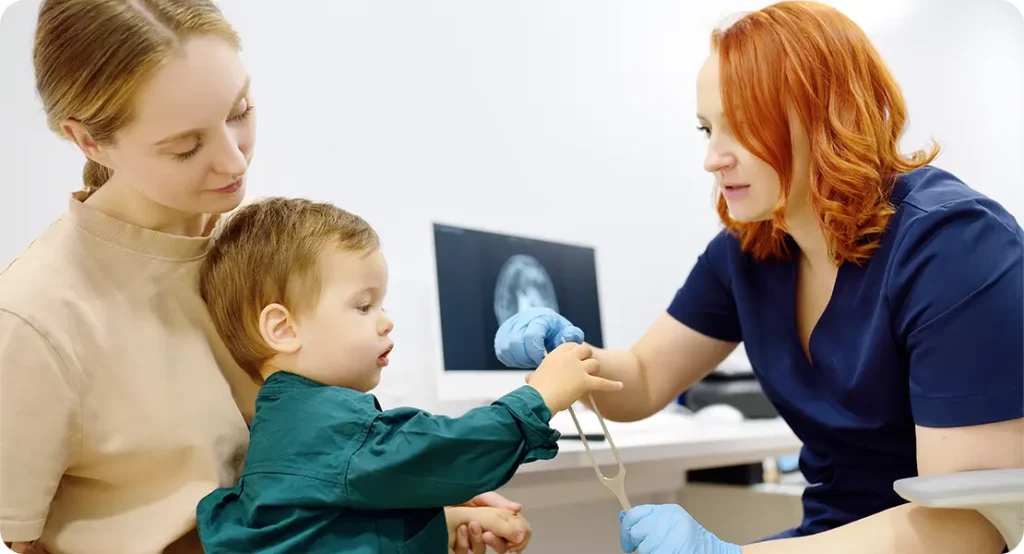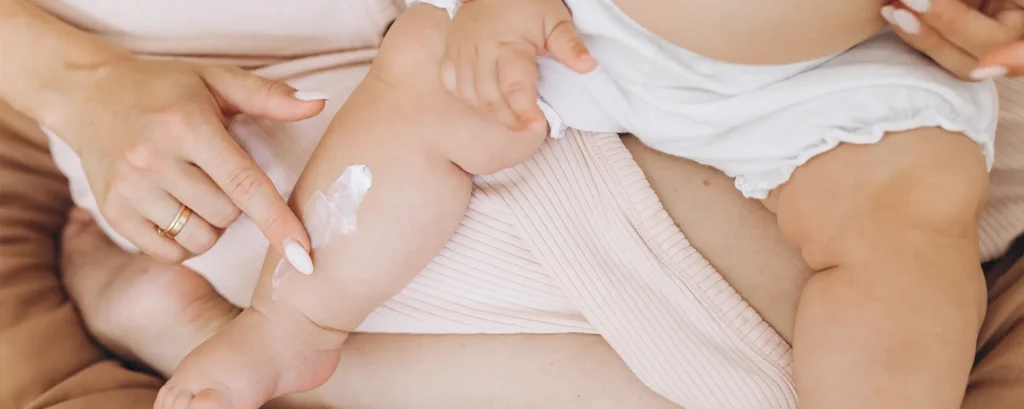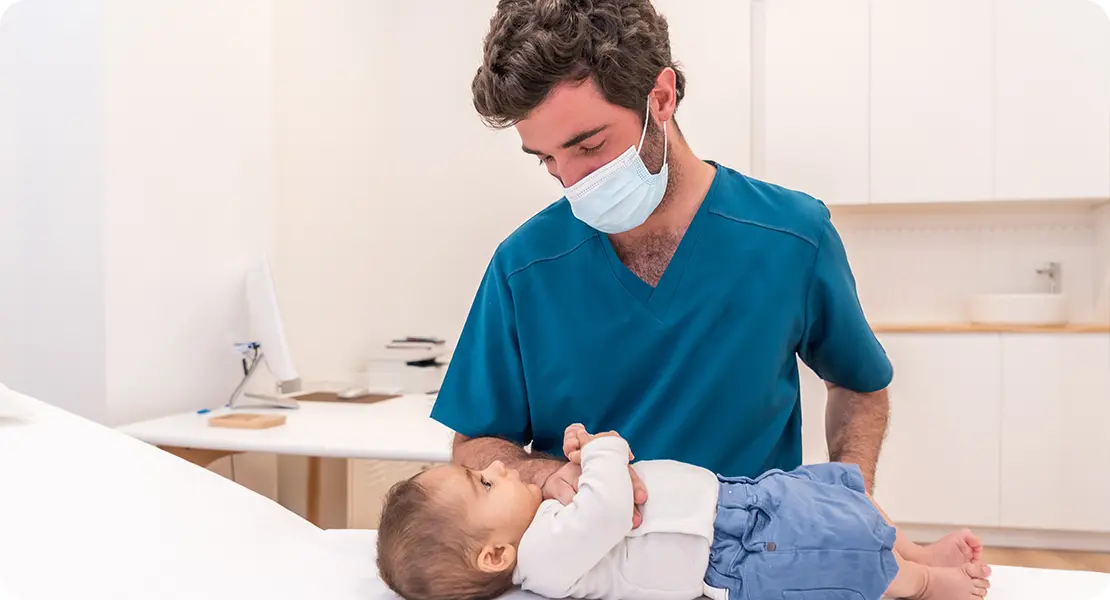Noticing that your newborn’s skin is peeling can be an emotional moment for parents. Some feel alarmed, others worry they may have done something wrong, and many simply don’t know if what they are seeing is normal. The truth is, skin peeling in newborns is extremely common, especially within the first two to three weeks after birth. Your baby’s skin is adjusting to life outside the womb, and in most cases, this shedding is just part of a completely natural process.
When babies are in the womb, their delicate skin is protected by a special waxy coating called vernix caseosa. This coating helps keep the skin soft and shielded from amniotic fluid. After birth, as the vernix wears off, the outer layer of skin naturally begins to dry and flake away. This can cause the skin to peel on the hands, feet, ankles, and sometimes across the body. For most infants, this type of peeling is mild, temporary, and requires no special treatment beyond gentle care and patience.
That said, not all peeling should be ignored. Parents should pay attention to how the skin looks and feels. If the peeling is accompanied by redness, swelling, cracking, bleeding, or if the baby seems uncomfortable or in pain, it may point to an underlying skin condition such as eczema, cradle cap, or even an infection. Environmental factors, like very dry air, frequent bathing, or harsh skincare products, can also make newborn skin more vulnerable.
Understanding the difference between harmless peeling and potential warning signs can give parents peace of mind and help them take the right steps to protect their baby’s skin. With the right knowledge, you can confidently decide when gentle at-home care is enough and when it’s best to speak to a healthcare professional. By learning what’s normal and what’s not, you’ll be better equipped to support your baby’s comfort and ensure their skin stays healthy during this delicate stage of early development.
1. Normal Newborn Skin Peeling

It’s very common for newborn babies to experience peeling or flaking skin during the first few weeks of life. Parents often notice this on the hands, feet, ankles, wrists, or even across the face. While it can look dramatic especially when larger flakes are visible it is almost always harmless and a natural part of your baby’s development. Understanding why it happens can help ease any concerns and prevent unnecessary worry.
Why does newborn skin peel?
- Adjustment to the outside environment: Inside the womb, your baby’s skin is protected by amniotic fluid, which keeps it constantly hydrated. Once your baby is born, their skin must adapt to much drier air. As a result, the outermost layer of skin dries out and sheds. This is similar to how adults may experience mild peeling after sun exposure or dry weather, but in newborns, it’s simply part of their normal adaptation.
- Vernix removal: Many newborns are covered in a white, waxy coating called vernix caseosa at birth. This substance acts like a natural moisturiser and shield, protecting the baby’s skin during pregnancy. After birth, the vernix either absorbs into the skin or is gently wiped away. Once it’s gone, the underlying skin can sometimes appear dry or flaky as it gets used to its new environment.
What does normal peeling look like?
Normal peeling is generally:
- Mild and patchy, often limited to certain areas rather than the whole body.
- Temporary, usually resolving within a few days to two weeks.
- Not associated with redness, swelling, bleeding, or discomfort.
In fact, most babies will go through this stage without needing any treatment. Gentle bathing, avoiding harsh soaps, and letting the skin shed naturally are usually all that’s required. Over time, your baby’s skin will develop its own stronger barrier, becoming softer, smoother, and less prone to flaking.
When is peeling more noticeable?
Peeling tends to be more visible in babies who are born a little overdue. That’s because their skin has spent longer in the amniotic fluid, which can cause the outer layer to soften and then shed more significantly after birth. This can sometimes look worrying to parents, but it is still considered a normal variation and doesn’t usually require medical attention.
In short, while newborn skin peeling might look unusual at first, it is almost always a harmless stage that resolves on its own. Your baby’s skin is simply going through a natural renewal process, adjusting to is new environment outside the womb.
2. When Peeling Might Indicate a Skin Condition
While most newborn skin peeling is completely normal and harmless, there are times when it can signal an underlying skin condition. Parents should pay close attention to how the peeling looks, whether it is accompanied by other symptoms such as redness, irritation, or swelling, and whether their baby seems uncomfortable. Recognising these differences can help you decide when to simply monitor at home and when to seek medical advice.
Eczema (Atopic Dermatitis)
- Eczema is one of the most common skin conditions in infants and can sometimes become noticeable in the first few months of life.
- It usually appears as red, itchy, and dry patches, often located on the cheeks, scalp, chest, arms, or the creases of the elbows and knees.
- Unlike normal newborn peeling, eczema is often persistent and can cause significant discomfort, with babies becoming fussy or restless from the itchiness.
- Flare-ups may be triggered by irritants such as harsh soaps, certain fabrics, changes in weather, or even food allergies.
- Early management such as using fragrance-free moisturisers and avoiding irritants can help, but if symptoms are severe, medical guidance is important.
Cradle Cap (Seborrhoeic Dermatitis)
- Another common condition in young infants, cradle cap often shows up within the first few months.
- It presents as yellowish, greasy, or waxy scales on the scalp, and sometimes in the eyebrows, behind the ears, or along skin folds like the neck.
- The affected areas may also show mild redness or irritation.
- Although it may look concerning, cradle cap is usually harmless and tends to improve on its own over time. Gentle washing and using a soft baby brush can help loosen the scales, though persistent cases may benefit from advice from a healthcare professional.
Other Conditions
- Sometimes peeling may be linked to an infection. If the skin looks red, swollen, warm to the touch, or if pus is present, this may signal a bacterial or fungal infection that requires medical treatment.
- In rare cases, genetic or metabolic conditions can cause persistent, widespread peeling that doesn’t improve with time. These are uncommon but important to identify early, so ongoing or severe skin problems should always be discussed with a doctor.
When to Seek Medical Advice
If your baby’s peeling skin is accompanied by pain, fever, oozing, or if they seem generally unwell, it’s best to seek medical attention promptly. Even if the symptoms are mild, parents should trust their instincts if something doesn’t feel right, speaking with a healthcare professional can provide reassurance and ensure proper care.
3. Tips for Caring for Peeling Baby Skin

A newborn’s skin is delicate and still developing, which means it needs a little extra care and attention. If your baby is experiencing peeling, the goal isn’t to stop the skin from shedding altogether since that’s a natural process but rather to keep the skin comfortable, protected, and healthy while it adjusts to the outside world. Here are some practical ways parents can help:
Gentle cleansing
- Stick to the basics when it comes to washing your baby. Use lukewarm water and, if needed, a very mild, fragrance-free baby cleanser. Most of the time, plain water is enough.
- Avoid harsh soaps, bubble baths, or adult skincare products, as these can strip away natural oils and leave the skin even drier.
- Keep bath time short around 5 to 10 minutes to prevent unnecessary dryness. Babies don’t get dirty the way older children do, so long soaks aren’t necessary.
Moisturise regularly
- After bathing, gently pat (don’t rub) your baby’s skin dry with a soft towel and apply a hypoallergenic baby moisturiser while the skin is still slightly damp. This helps “lock in” moisture.
- Choose products labelled for sensitive skin and avoid those with strong fragrances, alcohol, or unnecessary additives.
- If certain areas like the ankles, elbows, or cheeks are especially dry, a slightly thicker cream or ointment can be helpful. Your healthcare provider can recommend the safest options if you’re unsure.
Avoid over-bathing
- Bathing your newborn every single day isn’t required and can actually worsen dryness. In most cases, two to three baths a week is more than enough.
- Between baths, you can freshen your baby by gently wiping their face, neck, hands, and nappy area with a damp, soft cloth.
- Limiting baths helps preserve the natural oils in your baby’s skin, which are essential for keeping it supple and protected.
Dress appropriately
- Clothing plays an important role in keeping your baby’s skin comfortable. Stick to soft, breathable fabrics like cotton that allow airflow and reduce friction.
- Avoid wool or synthetic fabrics that may feel rough and cause irritation, especially over peeling areas.
- Pay attention to temperature. Overheating can lead to sweating and more skin irritation, while very cold air can dry the skin out further. Dress your baby in layers so you can easily adjust their clothing to the environment.
Additional care tips
- Trim your baby’s nails or use baby mittens if scratching becomes an issue. Even gentle scratching can worsen dry patches.
- If your home has very dry air, especially in winter, consider using a humidifier in your baby’s room to maintain moisture in the environment.
- Avoid talcum powder, medicated lotions, or products not specifically designed for infants, as these may irritate delicate skin.
- Resist the urge to peel or pick at the dry skin yourself this can damage the healthy skin underneath and increase the risk of irritation.
In most cases, peeling skin will improve naturally as your baby grows, and these care steps are simply a way to support the process. Within a few weeks, most parents notice that their baby’s skin becomes softer, smoother, and more resilient without the need for special treatments.
4. When to See a Dermatologist
For most babies, skin peeling is just part of a normal adjustment process and improves naturally with time. However, there are situations where it’s worth seeking professional guidance rather than waiting for the skin to settle on its own. A dermatologist, especially one who specialises in paediatric care, has the expertise to distinguish between harmless newborn peeling and signs of a condition that may need treatment. Consulting a professional can give you reassurance and, if necessary, a clear plan for keeping your baby’s skin healthy and comfortable.
You should consider contacting a healthcare professional if you notice:
- Persistent or worsening peeling
Natural peeling usually improves within a week or two. If the flaking continues well beyond this period, appears to worsen instead of settling, or spreads across large areas of the body, it may be a sign of something more than simple newborn skin changes. - Red, inflamed, or itchy patches
Normal peeling rarely causes redness or irritation. If the skin looks sore, your baby seems uncomfortable, or there are patches that appear rough and inflamed, this could point to conditions such as eczema or dermatitis. Babies with eczema may rub at their skin or seem restless due to itchiness, which is different from normal, harmless flaking. - Pus, bleeding, or signs of infection
Watch carefully for any signs of infection, such as yellowish crusts, oozing fluid, swelling, or areas that bleed when the skin flakes off. These symptoms indicate that bacteria or fungi may have entered the skin and medical treatment is needed quickly to avoid further complications. - Peeling with other health concerns
If peeling is accompanied by general symptoms such as a fever, poor feeding, lethargy, or unusual fussiness, it’s best to seek help straight away. While rare, these combined symptoms may indicate a more serious condition that requires prompt attention.
How a dermatologist can help
A paediatric dermatologist in London can carry out a thorough examination of your baby’s skin to determine whether the peeling is normal or linked to an underlying condition. They can:
- Reassure you when the peeling is harmless and part of normal newborn development.
- Provide safe, tailored treatment options such as emollients or medicated creams if needed.
- Advise you on the best skincare routine for your baby’s sensitive skin, including which products to use and which ones to avoid.
- Help identify environmental triggers or allergens that could be worsening your baby’s skin.
Why professional reassurance matters
Even if the issue turns out to be minor, consulting a dermatologist can provide parents with valuable peace of mind. Rather than worrying or second-guessing at home, you’ll know exactly what’s happening with your baby’s skin and how to care for it properly. Early guidance also helps prevent conditions like eczema or cradle cap from becoming more uncomfortable or difficult to manage.
In many cases, one simple consultation is all it takes to understand what’s going on and to feel confident about your baby’s care. And if further treatment is necessary, you’ll already have access to professional advice and safe, effective solutions.
Final Thought: Caring for Your Baby’s Delicate Skin
Peeling skin in newborns is often a normal part of adjusting to life outside the womb. However, persistent, inflamed, or spreading peeling should be evaluated to rule out eczema, cradle cap, or other conditions. Proper care, gentle skincare, and timely professional guidance can ensure your baby’s skin remains healthy and comfortable.
If you are concerned, you can book a consultation with our paediatric dermatologist in London to get personalised advice and reassurance for your little one.
References:
- Singh, G. (2008) Unraveling the mystery of vernix caseosa. Indian Journal of Dermatology, examined protective and adaptive roles of vernix during neonatal transition. Available via PubMed Central. https://pmc.ncbi.nlm.nih.gov/articles/PMC2763724/
- Oranges, T. et al. (2015) Skin Physiology of the Neonate and Infant. Highlights how retained vernix helps hydration, pH balance, and temperature regulation post-birth. Available via PMC. https://pmc.ncbi.nlm.nih.gov/articles/PMC4593874/
- Nobles, T. et al. (2023) Cradle Cap (Infantile Seborrheic Dermatitis). A comprehensive, peer-reviewed overview of cradle cap its presentation, benign nature, and parent guidance. Available on NCBI Bookshelf. https://www.ncbi.nlm.nih.gov/books/NBK531463/
- Fletcher, J. (2018) Newborn skin peeling: Causes, treatment, and home remedies. Offers clear insight into peeling due to vernix removal, timing, and care tips. Available at Medical News Today. https://www.medicalnewstoday.com/articles/322499
- Visscher, M.O. et al. (2022) Epidermal Immunity and Function: Origin in Neonatal Skin. Discusses vernix’s origins from skin cells and sebaceous lipids and its role in skin maturation. Available via Frontiers in Molecular Biosciences (doi). https://doi.org/10.3389/fmolb.2022.894496
